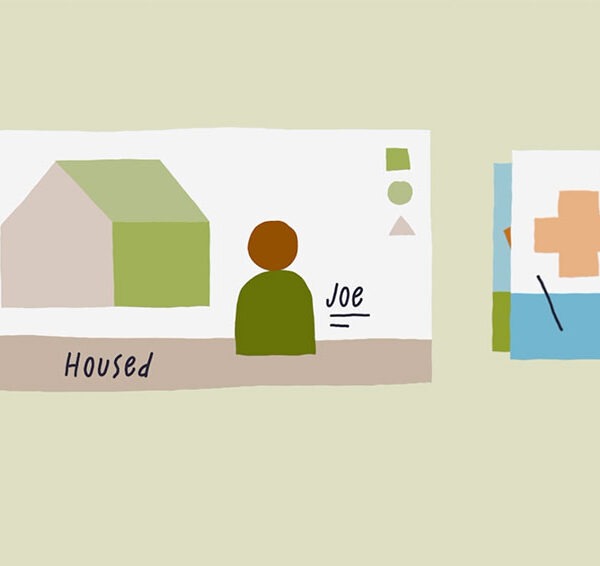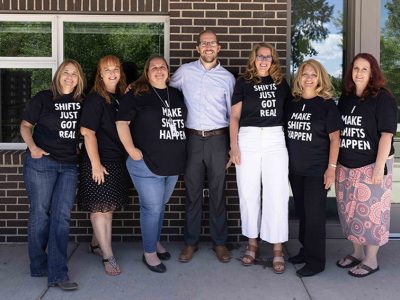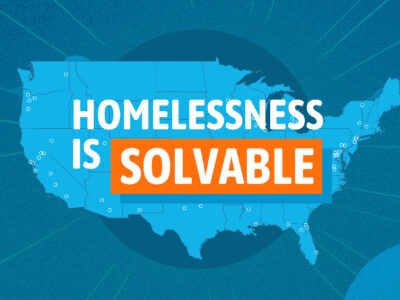
Making technology a catalyst for progress
Most Built for Zero communities report that technology is not currently a catalyst for ending homelessness.
Communities overwhelmingly depend on technology systems that do not provide the functionality or the comprehensive data they need. Communities rely on a tool called a Homeless Management Information System (HMIS), which is mandated by the U.S. Department of Housing and Urban Development.
The tool, which is primarily designed for grant and compliance reporting for federally funded programs, is not set up to integrate data across jurisdictions or with other systems, like health care. As a result, communities must expend significant energy to produce the clean, usable data that is needed to collaborate, solve problems, and drive reductions in homelessness. Our communities report that these onerous processes can overwhelm the already limited data capacity they have.
While solutions are urgently needed, existing software vendors lack either the capacity or incentive to address these problems.
In 2021, we worked with the Salesforce.org Impact Management Team to better understand these challenges, and how the burden for solving this problem might be shifted to software vendors and government actors who can create lasting and meaningful change. At the same time, we worked with Tableau to invest in building staff analytics capacity in the field.
Milestones
- We worked with Salesforce.org to understand the limitations of current data and technology standards in the homelessness sector, and to explore potential solutions.
- In partnership with Tableau, we launched the inaugural Built for Zero Data Fellowship with 16 leaders from Built for Zero communities, focused on building analytics skills across the field and developing a curriculum to support this approach for leaders throughout the movement.
Learnings
- Unlocking the potential of data and technology in our sector will require the adoption of new data standards. Drawing from an initiative in the health care sector known as SMART Health IT, we learned that improved data standards are critical for making the HMIS software market more competitive. These improved data standards also facilitated improvements in care coordination, data integration, and the ability to report population-level outcomes — all key elements of effective approaches to reducing and ending homelessness.
- Communities are eager for targeted learning opportunities and peer connection around data analytics. Data Fellows reported a desire for sector-specific content and ongoing small groups for continued learning and support, accountability for results, and the opportunity to refine their skills.

Bringing sectors together, starting with data
Ending homelessness is not the task of a single sector, but the work of an entire community. Being able to share appropriately protected data is the first step to working together.
Homelessness occurs when we allow people to crash through gaps in our social safety net. These gaps are filled when all upstream systems — like housing, health care, and the criminal legal system — take shared accountability for preventing and ending homelessness.
The first step in solving homelessness together is making sure all those who must collaborate can see the problem in the same way. Built for Zero communities maintain real-time, person-specific data on people experiencing homelessness. But actors outside of the homeless response system often cannot access this information in the absence of processes and agreements that address privacy concerns.
HEALTH SYSTEMS
Through a pilot initiative, we are working with health care leaders to overcome these challenges and harness their full potential in helping communities reduce chronic homelessness.
Guided by Community Solutions and the Institute for Healthcare Improvement, the Health Care and Homelessness Pilot Initiative creates avenues for collaboration between health care and homeless response systems in five Built for Zero communities.
HEALTH AND HOMELESS RESPONSE SYSTEMS PARTICIPATING IN THE PILOT
Bakersfield/Kern County, California – Kaiser Permanente, CommonSpirit Health
Washington County, Oregon – Kaiser Permanente, Providence Health System
Sacramento County, California – Kaiser Permanente, CommonSpirit Health, University of California – Davis Health, Sutter Health
Anchorage, Alaska – Providence St. Joseph Health
Chattanooga, Tennessee – CommonSpirit Health
Even as the demands of responding to Covid-19-challenged health systems, the partners remained committed to improving accountability and outcomes for people experiencing homelessness. They started by establishing goals and initiating key lanes of work. This required creating HIPAA-compliant data-sharing agreements and protocols to support sharing communities’ by-name data. Armed with this data, homelessness and health teams could more readily identify individuals experiencing homelessness, improve the coordination of care, align resources, and prevent people from being discharged from the hospital onto the street.
In Sacramento, the Continuum of Care lead agency (Sacramento Steps Forward) drafted a formal data-sharing agreement that would enable unidirectional sharing of persons experiencing chronic homelessness with four regional health systems: Kaiser Permanente, Dignity Health, UC Davis Health, and Sutter Health. The data will be matched against patient-level data in each system in order to better understand health trends among chronically homeless patients, the net impact on local emergency departments, and to establish a baseline to measure planned intervention strategies to accelerate housing placements. Aggregate level data will be shared back with Sacramento Steps Forward to create a comprehensive picture of chronically homeless patients served by health local systems, as well as the opportunities for improved coordination with the Continuum of Care to improve long-term patient health and housing outcomes. All of these agreements are undergoing review by each health system for approval.
CRIMINAL JUSTICE SYSTEM
The experience of homelessness is deeply intertwined with the criminal justice system. In 2019, Community Solutions began to focus on two zip codes in North Hartford, Connecticut, with the highest rates of homelessness with the goal of eliminating inflow into homelessness. After analyzing local system data and conducting interviews with residents who were experiencing homelessness, a clear picture emerged.
Almost 40% of those with lived experience cited exposure to the criminal justice system as a driver of their homelessness. People were exiting prison, jail, or pre-trial detention and struggling to access housing, despite the fact that services were available to support them.
The homeless and criminal justice systems have partnered together to address this dangerous gap. This team includes the Department of Corrections, which oversees people in jails and prisons; Court Support Services Division, which oversees the detention and release of individuals in pretrial proceedings and probation; Hartford Police Department; the re-entry providers (Community Partners in Action and Greater Hartford Welcome Re-entry Center) that supports justice-impacted people returning to their communities; and the Greater Hartford Coordinated Access Network, the local homeless response system.
In 2021, the team worked on barriers to data sharing — like privacy concerns and limited staff capacity — and was able to make progress on agreements across sectors. These allowed information to be shared in order to design interventions with the right support and referrals for individuals at risk of homelessness.
Milestones
- Health and homeless services systems in five communities committed to working together to reduce and end chronic homelessness.
- All five communities in the health care pilot made progress on establishing data-sharing agreements, which would equip the homeless and health systems with information needed to advance their shared goals and deliver improved health and housing outcomes for those experiencing chronic homelessness.
- The Connecticut Department of Corrections, Court Support Services Division, Hartford Police Department, Re-Entry Partners, and local homeless response system partnered to disrupt the trend of people exiting incarceration and entering into homelessness, focusing on data-sharing, designing joint interventions and services, and identifying individuals at risk of becoming homeless sooner.
Learnings
- Establishing data-sharing agreements may be one of the most important steps in unlocking the role of health care in ending homelessness. While health systems must address privacy concerns from various sources — ranging from their own internal legal departments to HIPAA — all the participating systems made progress in addressing barriers to data-sharing.
- Data-sharing between the criminal justice and homeless response systems is a vital step to moving upstream of homelessness. The ability to share this information across systems creates space for improved policies, programs, and ultimately coordination of resources and care for individuals at risk of homelessness or experiencing homelessness. As one example, Court Support Services administered housing surveys to identify individuals at risk of becoming homeless and a process for referring them to the partners that could address their housing needs.
More from the 2021 Impact and Learning Report

The future we can build, together
It’s 2026. Homelessness is no longer seen as intractable, and ending it is no longer seen as exceptional. It’s expected.













